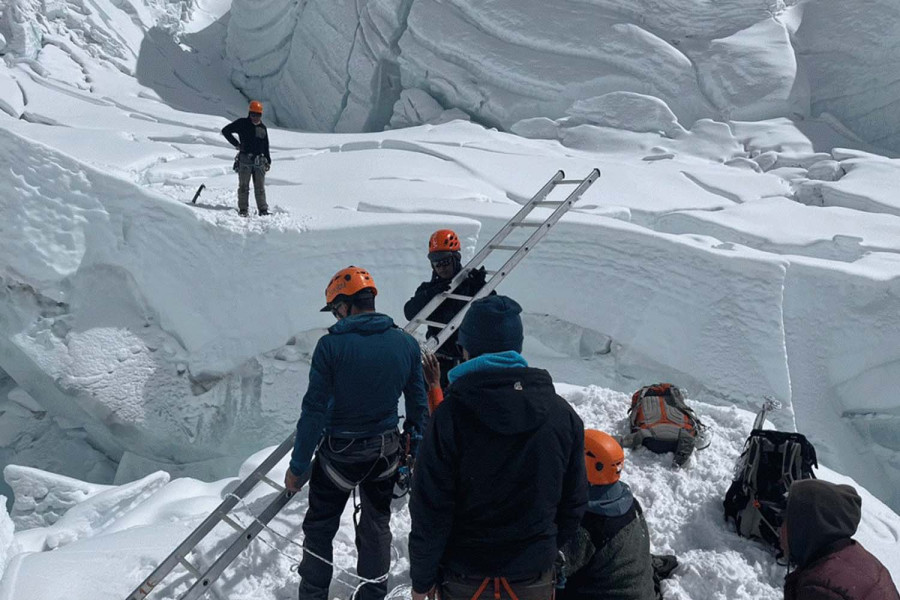National
Rescuers abandon search for guides buried in Everest
Millions of tonnes of ice moved downslope and covered the three Sherpas in season’s first accident on the tallest peak.
Sangam Prasain
Rescuers on Wednesday abandoned the mission to search three Sherpa guides buried underneath the snow on Everest saying it was “impossible” to find them alive.
Millions of tonnes of ice masses moved downslope and buried the high-altitude Sherpa guides, on Wednesday morning, in the season’s first accident on the world’s tallest peak.
Lakpa Norbu Sherpa, the Everest base camp coordinator of the Himalayan Rescue Association, told the Post from the base camp that the massive ice sheet of more than 50 metres tumbled down the mountain, below ‘Camp 1’ at 5,700 metres, and buried three guides.
The possibility of finding the missing climbers alive is thin, he said.
“They may have been buried five to six metres underneath or more. We are not sure how deep,” said Norbu Sherpa, who is also a long-line rescue specialist.
“The ice sheets are as big as houses. It’s not possible to dig either,” he said.
The accident took place at 9:30 am when a team of around 25 high-altitude guides from Imagine Nepal Trek and Expedition were climbing above the Khumbu Icefall to prepare the route from ‘Camp 2’ to the summit, said Norbu Sherpa.
“It’s not that they fell into crevasses. They are buried under the ice masses in the Khumbu Icefall, the most dangerous section of Everest,” said Norbu.
Surendra Paudel, a Simrik Air captain, who conducted the search and rescue mission said three rescuers were dropped near the site in three flights. “We reached the site which is also locally known as ‘football field’ at 11:15 am.”
Ang Tashi Sherpa, another rescue specialist, said it’s not possible to dig up the snow.
“The rescuers gave up. We don’t know whether the search operation will continue.”
The icefall doctors mobilised by the Sagarmatha Pollution Control Committee, an agency authorised to fix ropes and ladders up to Camp 2 on Everest, had completed preparing the route from base camp through the Khumbu Icefall to Camp 2 last Thursday.
This season, the task of preparing the route from Camp 2 to the summit, has been given to Imagine Nepal Trek and Expedition.
The route-fixing team was led by Dawa Gyalje Sherpa. They moved towards base camp on April 5 to prepare the route.
The passage through the Khumbu Icefall, the route that leads to the world’s tallest peak, is so notoriously dangerous that even experienced Sherpas hesitate to move when the sun shines. The Khumbu Icefall stretches from 5,500 to 5,800 metres and lies just above the Everest base camp.
The Khumbu Icefall, a river of ice—a kilometre or so long—is normally crossed during the night or early morning with climbers using headlamps.
Normally, the route is crossed between 3am and 5am, the time when the ice blocks and the hanging glaciers are stable and avalanche risks are low.
On April 18, 2014, an avalanche resulting from a falling serac buried 16 sherpa guides in the Khumbu Icefall which led to the cancellation of the season’s expeditions. Thirteen bodies were recovered within two days, while the remaining three were not found. This was the same icefall where the 1970 Everest disaster had taken place. In April 1970, six Sherpas died on Everest, caused by an ice-fall avalanche in the Khumbu Icefall.
In April 2015, an earthquake triggered an avalanche on Everest, killing 22, the deadliest incident on the mountain on record.
The Himalayan Database has recorded 44 deaths on the Khumbu Icefall from 1953 to 2016.




 13.12°C Kathmandu
13.12°C Kathmandu















